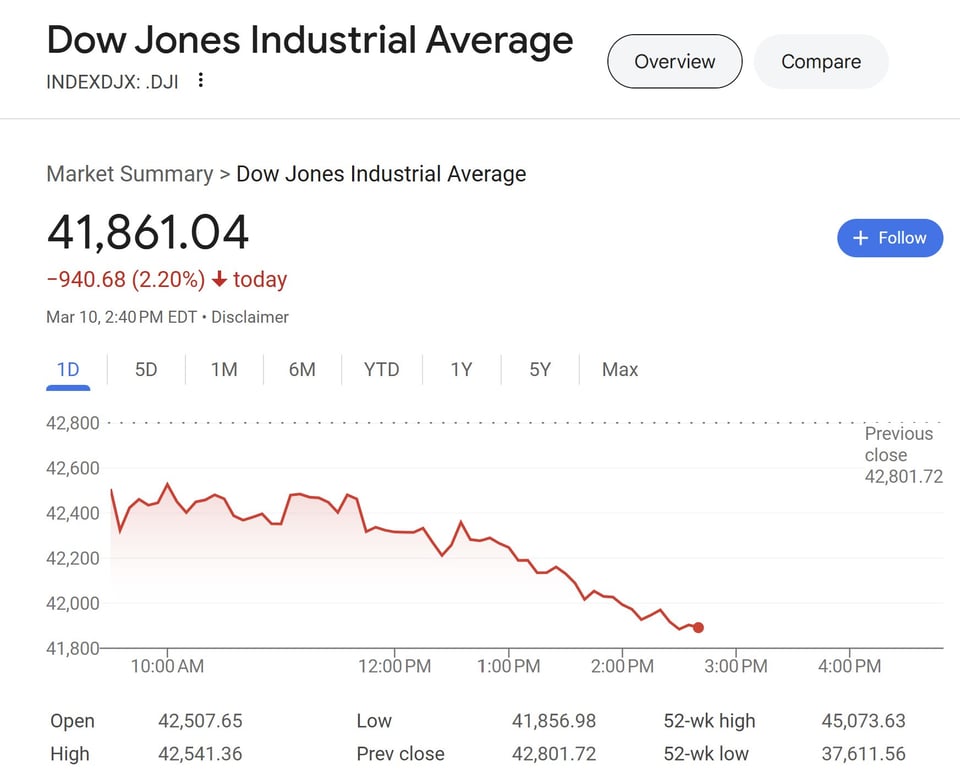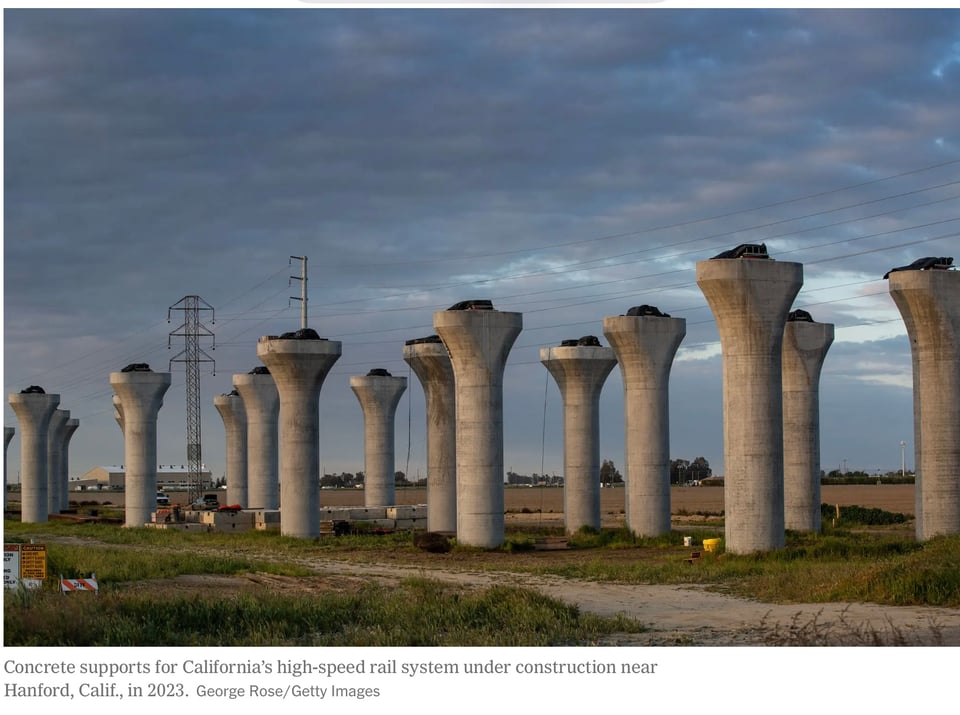Tuesday, March 11, 2025. Annette’s Roundup for Democracy.
This ‘n That.
First direct effect of Trump tariffs on Canada.
JUST IN: Ontario slaps 25% increase on electricity exports to U.S. in response to Trump's trade war. Canada’s most populous province provides electricity to Minnesota as well as New York and Michigan. https://t.co/RmHbl5ybv3
— The Minnesota Star Tribune (@StarTribune) March 10, 2025
The first victims of Trump’s trade war? Minnesotans struggling to pay their skyrocketing electric bill.
— Governor Tim Walz (@GovTimWalz) March 10, 2025
Minnesota cannot afford Trump’s billionaire-run economy. We have to put a stop to this madness. https://t.co/g2Dq3MHzjv
American Universities are no longer sanctuaries of free speech.
NEWS: Last night, DHS detained a Palestinian who helped lead Columbia encampment.
— Prem Thakker (@prem_thakker) March 9, 2025
Agents told him his visa was revoked. He said he had a green card. They were confused—then said that was revoked too.
His attorney demanded a warrant. Agents hung up instead.https://t.co/4t2RByUI1x

Senator Mark Kelly and Trump’s Henchman.
Just left Ukraine. What I saw proved to me we can’t give up on the Ukrainian people. Everyone wants this war to end, but any agreement has to protect Ukraine’s security and can’t be a giveaway to Putin. Let me tell you about my trip and why it’s important we stand with Ukraine.🧵 pic.twitter.com/6kOw1tTgS6
— Senator Mark Kelly (@SenMarkKelly) March 9, 2025




Ruth Marcus has resigned from the Washington Post as columnist and associate editor.
Top 'Washington Post' columnist resigns, accusing publisher of killing piece
A top political columnist for The Washington Post resigned today, accusing Post chief executive and publisher Will Lewis of killing her column that criticized owner Jeff Bezos's drive to overhaul the opinion pages to focus on his libertarian priorities.

Post columnist and Associate Editor Ruth Marcus, who has worked at the paper for four decades, says she can no longer stay there.
"Jeff's announcement that the opinion section will henceforth not publish views that deviate from the pillars of individual liberties and free markets threatens to break the trust of readers that columnists are writing what they believe, not what the owner has deemed acceptable," Marcus wrote in a resignation letter obtained by NPR.
More than 75,000 digital subscribers canceled in the 48 hours after Bezos revealed his intentions late last month, which included an edict that the paper would not print opposing views; then Opinions Editor David Shipley stepped down after vainly trying to dissuade Bezos from his course.
Marcus confirmed to NPR she had resigned and the authenticity of the letter but declined further comment.
"Will's decision to not …run the column that I wrote respectfully dissenting from Jeff's edict - something that I have not experienced in almost two decades of column-writing - underscores that the traditional freedom of columnists to select the topics they wish to address and say what they think has been dangerously eroded," she wrote.
"We're grateful for Ruth's significant contributions to The Washington Post over the past 40 years," a spokesperson for the paper said in a statement shared with NPR. "We respect her decision to leave and wish her the best." The Post did not address her allegations against Lewis.
A killed endorsement to avoid 'perception of bias'
In late October, Bezos killed a planned endorsement of Democratic presidential nominee Kamala Harris. That sparked 300,000 digital subscribers to cancel in the days that ensued.
And it raised questions about Bezos's motivations to his critics, who note that he is the executive chairman of Amazon and founder of Blue Origin, which together have billions of dollars of business with the federal government.
"What presidential endorsements actually do is create a perception of bias," Bezos wrote in a opinion piece explaining his decision. "A perception of non-independence. Ending them is a principled decision, and it's the right one."
Bezos has also moved closer to President Trump since the election, traveling with his fiancée to Mar-A-Lago to dine with the Trumps, paying $1 million toward his inauguration fund, sitting on the inauguration platform with other tech titans during the swearing in ceremony, and dining with Trump again late last month in Washington.
Amazon studios have approved two deals for documentaries involving the Trumps, one of which includes a $40 million payout to Melania Trump, according to Puck News.
'Post' blocks coverage of fallout at the paper
All this led to critical columns about the endorsement decision in the Post's own pages and multiple resignations by editorial board members and by contributors to the wider opinions section. Shipley, while still editor, killed a cartoon late last year by Pulitzer Prize-winner Ann Telnaes showing Bezos among the media and tech figures abasing themselves before Trump; she resigned. A deluge of veterans have taken jobs at competing news outlets.
The Post's top news editor, Matt Murray, blocked reporters from covering the fallout at the newspaper, as NPR has reported.
Bezos' decisions about the opinion pages led veteran journalists who have been a part of the Post for decades to cut ties, including Associate Editor David Maraniss and former Senior Managing Editor Cameron Barr.
In her resignation Monday, Marcus said she had served at the Post as a reporter, deputy national editor, editorial writer, deputy editorial page editor before becoming a columnist and associate editor.
"I love the Post," Marcus wrote at the end of her resignation letter. "It breaks my heart to conclude that I must leave. I have the deepest affection and admiration for my colleagues and will miss them every day. And I wish you both the best as you steer this storied and critical institution through troubled times." (NPR)


Insider Trading.


Critiquing the Democrats.
Rebecca Traister - What is wrong with these people.*
Democratic Party Leadership.
In the midst of all this malevolence and peril, some Congressional Democrats responded with fury! Fury! At Al Green, the eleven-term Democratic Congressman from Texas who had the moral fortitude and basic human decency to stand up during Trump’s speech to Congress on Tuesday and yell, among other things, “You have no mandate to cut Medicaid!”

Green was forcibly removed from the chamber, and on Thursday, ten Democrats voted with Republicans to censure him for his righteous behavior, forcing him into the well of the House to be publicly shamed. Thankfully, a couple dozen of his Democratic colleagues—including Ayanna Pressley, Rashida Tlaib, Maxine Waters and Ilhan Omar—surrounded him there in support, singing “We Shall Overcome” as Speaker Mike Johnson tried unsuccessfully to silence them.
But the spirit of solidarity did not animate Democratic leadership, who in the days after Trump’s speech called in others who had been disruptive—including Texas’s Jasmine Crockett, Florida’s Maxwell Frost, Oregon’s Maxine Dexter (who tweeted “I left the State of the Union because I will not dignify his cruelty”) and New Mexico’s Melanie Stansbury, who held up a hand-written sign reading “this is not normal”—to lecture them about the behaviors that party leadership saw as undignified. An Axios story about that meeting included one of the funniest-not-at-all-funny quotes I have read recently: “They are not being talked to like they are children,” a source who may or may not have been Dr. Becky assured the reporter about leadership’s disciplinary approach, “We are helping them understand why their strategy is a bad idea.”
Meanwhile, in the same week that it was reported that incarcerated trans women have been forcibly moved to men’s prisons in defiance of court rulings claiming that Trump had no standing to order it, California governor Gavin Newsom decided it was a perfect time describe trans athletes’ participation in sports as “deeply unfair.” At the Atlantic, Tim Alberta spoke with Michigan’s Elissa Slotkin about how Democrats’ imaginary history of enforced “land acknowledgements [and] pronoun policing” was “weird,” taking what was one of the best communicative weapons Democrats ever deployed against Trump and his boys, and turning it instead on themselves. Meanwhile the New York Times reported on politicians, university presidents, and business leaders who want to speak out against the administration but are scared about the retributive harm that will befall them and their families. This is a real and terrifying dynamic, designed to quell dissent from the powerful, and the speed with which it has done just that must be particularly devastating for the millions of less powerful people and their families who are already being harmed by the administration.
How can political opposition possibly weaken itself any farther than through this kind of gutlessness and garbage capitulation to nasty, fictionalized narratives crafted by the cruel autocrats they’re supposed to be standing up to? It is so possible to be the Good Guys in this moment! These leaders are in a position to challenge an administration that is taking away healthcare, jobs, social security, dignity and democracy; Musk and Vance and Trump and Vought aren’t metaphorical supervillains, they are actual supervillains, who have adopted an actual horror movie prop to enact a chainsaw massacre of our democracy, the economy, and our basic civil rights and protections.
But somehow any pushback more profane or disruptive than the little hand paddles raised by some Democrats during Trump’s speech—as if this were an afternoon at Sotheby’s, our wellbeing and future as a nation on the block—is too over-the-top, too rude, too unruly.
And look, this is not new. This is exactly how Democratic leadership acted back in the summer of 2018, when Maxine Waters, then going head to head with Trump over child separation and the righteousness of protest, was scolded by leadership of her own party. During that summer I wrote about the suffocating calls from the left for "civility,” always a code word for the protection of those already in power from those who object to how they wield that power. "To publicly rebuke a Black woman’s support for protest, and not the powerful white patriarch’s thinly veiled call to violence against her is to play on the very same impulses that Trump himself plays on,” I wrote six years ago, in a piece that could have been more or less written about the party’s treatment of Al Green and his fellow protesters this week.
Not for nothing, after that rageful 2018 summer of protest and discomfiture of the powerful—behaviors that party leaders were so sure were going to be a turn-off to voters—Democrats won in the biggest blue wave in decades.
So right now I’m focusing on sending thanks and acknowledgment to the Democrats who are taking this seriously, including those who gathered round Green in the well, the ones who got gentle-parented by Hakeem Jeffries, plus the lawmakers who did not even attend the speech, including New York’s Alexandria Ocasio-Cortez and Washington Senator Patty Murray and Connecticut’s Chris Murphy and Hawaii’s Brian Schatz. I also want to cite some of the more moderate voices who have been standing up, including my home state politicians Janet Mills (whose politics I do not like when it comes to criminal justice but whose willingness to defy the president regarding the state’s protection of trans athletes has been extraordinary so far) and Independent Angus King, whose Senate floor speech in early February was excellent.
I cite King in particular because I want to be clear that I am not suggesting a one-size fits all strategy for Democrats here. While my politics are left-progressive, and while I happen to respond warmly to pushy expressions of rebuke, I don’t believe there is any one tactic that will fix this grievous mess. I don’t think that every form of activist-protest is the answer, and I am not looking only to the politicians I’m most aligned ideologically for leadership. I believe that this period requires as many approaches to resistance as there are humans (and leaders) who understand the need to resist this administration’s terrifying overreach and destruction. Some of them will come from left-wing agitators, some will come from centrist defenders of norms; presumably they will reach different audiences and resonate for different sensibilities; some attempts will succeed in channeling public dismay and slowing the harm, others will surely fall flat.
The unforgivable error in my eyes is the choice of otherwise listless Democratic leadership to train its fury not at the malevolent Trump-Vance-Musk regime, but instead on the Democrats who have chosen to be vocal in their challenge, in their insistence in conveying that this is not normal, this is not mere partisan disagreement, that this is cruel and unlawful and fundamentally illegitimate. Resistance can look a million different ways, but if it’s aimed not at the abusers of power but at those with significantly less power (seriously, fuck Gavin Newsom) then it smells bad and right now the top of the Democratic party stinks like a dead mackerel, and is acting with about as much energy.
So I’m looking at the extraordinarily brave people out there who don’t have the power or protection of Hakeem Jeffries or Chuck Schumer or Nancy Pelosi, but who seem to understand far better than these lawmakers what is at stake, and behave accordingly, despite the risks and consequences being far graver for them. I’m looking to people like Frank Zamorra, the Texas Real Estate Commission employee who got fired for refusing to remove his pronouns even after having been ordered to do so and who simply explained to the Austin American-Statesman, “I could not, in good conscience,
contribute to those actions in any way—no matter how small."
I’m thinking of my friends in Houlton, Maine, the very conservative rural Maine county where my mother and grandfather and great-grandfather and great-great grandfather grew up. Fifty-two Houlton residents came out this week in the biting cold, standing in slush and ice with signs about restoring democracy, waving flags for Ukraine and LGBTQ rights. A few days later, a group of my friends spoke to an ABC affiliate about the devastating impact that Trump’s on-again-off-again tariffs on Canada are having on their border community.
Can Democratic House leadership, or the Republican lawmakers we keep reading are terrified of Trump retribution, even begin to imagine how hard it is to be a public political dissenter in Texas, or in a small conservative town where everyone knows everyone else? These lawmakers who are so afraid of losing their political power, power that’s theoretically theirs because constituents hired them to fight for things they believe in: can they conceive of someone like Zamora, whose job may have had nothing to do with fighting for justice, but who lost it nonetheless, because having that fight was the right thing to do?
I promise (perhaps for some subscribers, this should be a warning) that not all of these Substack entries will be political rants. It would get boring, and I would just repeat myself; in fact, I sometimes feel as though I’ve been repeating myself for 20 years.
Also I am sinking into my book research, which begins in 1920s Germany and extends to the beginning of the 21st century in New York City. It feels good to be looking toward the past, even some of the ugliest parts of the past, because it is possible to see how people fought through and eventually emerged from global political crisis.
Spoiler alert: It was not by censuring Al Green.
— I have two big reading recommendations this week. The first is Jamelle Bouie’s brilliant column on Trump’s revenge campaign against the American people.
— The second is this by Gillian Branstetter, about how getting mad online (like I’m doing here, perhaps) can get converted into fuel by the civility-mongers. It has not convinced me to stop getting mad online, but rather to think about how power structures work cleverly to contain and minimize challenge to those structures. (Rebecca Traister, Substack).
Ezra Klein - There Is a Liberal Answer to the Trump-Musk Wrecking Ball.
I keep seeing Democrats say the resistance failed. On these pages, James Carville counseled Democrats to “roll over and play dead” until the Trump administration collapses beneath its own weight. Assuming corpse pose, Carville said, would be “a wiser approach than we pursued in the first Trump administration, when Democrats tried and failed at the art of resistance politics.”
But Democrats succeeded at the art of resistance politics. They won the 2018 midterms, flipping 40 House seats, seven governorships and six state legislatures. Democrats won the 2020 presidential election, driving Donald Trump into exile in Mar-a-Lago. The resistance succeeded. The problem was what came next — and, in some ways, what had come before: Democrats failed at the work of governing.
Trump won in 2024 because Americans were furious about the cost of living and they trusted Republicans, not Democrats, to lower it. Part of that was the burst of post-pandemic inflation that deranged the economy from 2021 to 2023. But in 2020, before that burst, exit polls showed voters evenly split on whether they trusted Trump or Joe Biden to manage the economy. In 2016, Trump led Hillary Clinton on that question.
I know many Democrats believe this is a byproduct of Trump’s years of playing a businessman on TV. That may be part of it. But Democrats allowed an affordability crisis to metastasize on their watch in ways they cannot blame perception or messaging for. If they are going to marginalize MAGA, they need more than a resistance; they need new answers that admit past failures.

Look at the places Democrats govern — liberal strongholds like New York, Illinois and California. In 2023, California saw a net loss of 268,000 residents; in Illinois, the net loss was 93,000; in New York, 179,000. Why are they leaving? In surveys, the dominant reason is simply this: The cost of living is too high. It’s too expensive to buy a house. It’s too expensive to get child care. You have to live too far from where you work. And so they’re going to places where all of that is cheaper: Texas, Florida, Arizona.
For Democrats, this is a political crisis. In the American system, to lose people is to lose power. If these trends hold, the 2030 census will shift the Electoral College sharply to the right. The states that Kamala Harris won in 2024 will lose perhaps as many as a dozen House seats and Electoral College votes. The states that Trump won would gain them. In that Electoral College, a Democrat could win every state Harris won in 2024; add in Michigan, Pennsylvania and Wisconsin; and still lose.
But it is also a spiritual crisis: You cannot be the party of working families when the places you govern are places working families cannot afford to live. You are not the party of working families when the places you govern are places working families can no longer afford to live.
This is the policy failure haunting blue states. It has become too hard to build, and too expensive to live, in the places where Democrats govern. It is too hard to build homes. It is too hard to build clean energy. It is too hard to build mass transit. The problem isn’t technical: We know how to build apartment complexes and solar panel arrays and train lines. The problem is the rules and the laws and political cultures that govern construction in many blue states.
The Second Avenue Subway project in New York City was the most expensive subway project, by kilometer, that the world has ever seen. Has New York reformed its policies to make the next expansion easier and cheaper? No, it hasn’t. Did the decades of delay and the billions of cost overruns on Boston’s Big Dig change how Massachusetts builds? Not really. California has the worst housing problem in the country. The state has 12 percent of the country’s population, 30 percent of its homeless population, and 50 percent of its unsheltered homeless population. Has this undeniable failure led to California building more homes today than it was building a decade ago? No.
I could tell you a dozen stories — and in my new book, I do — but let me tell you just one.
In 1982 — more than 40 years ago — Gov. Jerry Brown signed a bill to study what it would take to build a high-speed rail system across California. He liked what he saw, and so did California’s voters. In 1996, California formed a high-speed rail authority to plan for its construction.
High-speed rail is not some futuristic technology like nuclear fusion or flying cars. Japan broke ground on high-speed rail back in 1959. You can ride these trains today across Japan and Europe and China.
In 2008, California’s voters approved Prop 1A, which set aside $10 billion to begin construction on a high-speed rail line that would connect Los Angeles and San Francisco, running through the Central Valley, in 2 hours and 40 minutes. It would cost, they thought, $33.6 billion, and Californians would be able to ride by the year 2020.
Prop 1A passed. And the news kept getting better for high speed rail. In 2009, President Barack Obama signed the American Recovery and Reinvestment Act into law. It had hundreds of billions to build the infrastructure of the future. And high-speed rail had captured Obama’s imagination.
“Imagine boarding a train in the center of a city,” Obama said in April 2009. “No racing to an airport and across a terminal, no delays, no sitting on the tarmac, no lost luggage, no taking off your shoes. Imagine whisking through towns at speeds over 100 miles an hour, walking only a few steps to public transportation, and ending up just blocks from your destination. Imagine what a great project that would be to rebuild America. Now, all of you know this is not some fanciful, pie-in-the-sky vision of the future. It is now. It is happening right now. It’s been happening for decades. The problem is it’s been happening elsewhere, not here.”

Obama wanted it to happen here. And California, where the voters had already begun planning and funding it, was the obvious place. And politically, the stars kept aligning. In 2011, high-speed rail’s foremost champion returned when Jerry Brown won back the governorship, almost 30 years after leaving it. In his 2012 State of the State address, he marked high-speed rail as his signature project.
“If you believe that California will continue to grow, as I do, and that millions more people will be living in our state, this is a wise investment,” he said, adding, “We are within weeks of a revised business plan that will enable us to begin initial construction before the year is out.”
It didn’t happen. By 2018, it was brutally clear that nothing was going to be ridable by 2020. And the cost estimate wasn’t $33 billion anymore; it was $77 billion.
In 2019, Gavin Newsom, who had served as Brown’s lieutenant governor, succeeded Brown as governor. And in his first State of the State address, Newsom admitted what everyone already knew.
“Let’s be real,” Newsom said. “The project, as currently planned, would cost too much and take too long. There’s been too little oversight and not enough transparency. Right now, there simply isn’t a path to get from Sacramento to San Diego, let alone from San Francisco to L.A. I wish there were.”
In October 2023, I went to Fresno, Calif., and toured the miles of rail infrastructure that the California High-Speed Rail Authority has built.
The project is caught in a strange limbo between political fantasy and physical fact. The agency doesn’t have anywhere near the money or political capital it would need to complete the Los Angeles-to-San Francisco line Californians actually want, a system that is now estimated to cost $110 billion. It doesn’t even have the money to complete the Bakersfield-to-Merced segment that Newsom proposed. It has no line of sight on how it will get that money or that political capital. But since it has some money and some political capital, it is building anyway, in the hopes that Californians will want to finish what they started.
How did this happen? What I heard as I walked that track with the engineers who built it was less about engineering problems than political problems. I stood on a patch of the 99 freeway that had been moved in order to clear the hoped-for train’s path. Not far away there had been a self-storage facility. In folk imagination, eminent domain is a simple process by which the state simply tells you it wants your land and then gives you some money and takes it from you. In reality, it took the High-Speed Rail Authority four separate requests for possession, and two and a half years of legal wrangling, to get that little spit of land.
That story repeated itself again and again. There are parts of the high-speed line that intersect with freight rail lines. But the freight rail lines are so busy in the holiday season that some impose a construction moratorium from October to December. So in those areas work has to stop.
Trains are cleaner than cars, but high-speed rail has had to clear every inch of its route through environmental reviews, with lawsuits lurking around every corner. The environmental review process began in 2012, and by 2024, it still wasn’t done. “I’m always amazed the staff has been working on these segments for a decade or longer to get through the environmental process,” Brian Kelly, the chief executive of the High-Speed Rail Authority from 2018 to 2024, told me.
Many Californians were confused that construction had begun in the Central Valley, which was far less populated than the corridors near Los Angeles or San Francisco. Why did the Authority begin construction there?
One reason was that when California applied for federal money, the Obama administration wanted bids that would improve air quality in poor communities. And so the $3 billion the federal government offered was not really to build high-speed rail. It was to begin building high-speed rail in ways that addressed air pollution in specific communities.
The Central Valley is poorer and more polluted than coastal California, so federal funding went there, and so did the initial construction. But that made it less likely high-speed rail would generate the ridership, political support and financial backing to ever finish.
What has taken so long on high-speed rail is not hammering nails or pouring concrete. It’s negotiating. Negotiating with courts, with funders, with business owners, with homeowners, with farm owners. Those negotiations cost time, which costs money.
Those negotiations lead to changes in the route or the design or the construction, which costs money and time. Those negotiations are the product of decades of liberal policies meant to protect against government abuses. They may do that. But they also prevent government from building quickly or affordably.
“Time is a killer on the estimate of a project’s cost,” Kelly said. “When you don’t have funding and can’t make decisions and can’t drive to get operational and you can’t move the ball — the cost is huge: 2 to 3 percent a year, and in higher inflation periods, like we just had, 5 percent.” As delays mount, costs keep rising. The project becomes more expensive to finish. The public loses faith. The politicians begin second-guessing.
“I watched as a mayor and then a lieutenant governor and now governor as years became decades on high-speed rail,” Newsom told me. “People are losing trust and confidence in our ability to build big things. People look at me all the time and ask, ‘What the hell happened to the California of the ’50s and ’60s?’”
In the time California has spent failing to complete its 500-mile high-speed rail system, China has built more than 23,000 miles of high-speed rail. China does not spend years debating with judges over whether it needs to move a storage facility. That power leads to abuse and imperiousness. It also leads to trains.
I do not want America to become China. But I do want it to be able to build trains.
This is an awkward time to make this argument. Elon Musk and his so-called Department of Government Efficiency are trying to raze the federal government under the moniker of “efficiency.” But driving out talented employees and slashing capacity indiscriminately will not make government more efficient. Neither Musk nor Trump seeks a more capable state; they seek a broken state that they can control and corrupt.
Donald Trump could have run on bringing Texas housing policies to the nation. In Houston, there’s no zoning code, so building is easy, and the median home price is over $300,000. Compare that with Los Angeles, where the median price is around a million dollars. Or look at Austin, which has been a popular destination for many fleeing San Francisco’s housing costs. In November 2024, San Francisco’s metro area authorized the building of 292 housing structures; Austin authorized 3,059.
In the 2024 campaign, Trump and Vance ran on none of that. Instead, the housing crisis became a cudgel against immigrants. “Illegal aliens competing with Americans for scarce homes is one of the most significant drivers of home prices in the country,” JD Vance said in the vice-presidential debate. Trump sounded the same theme. Voters “cannot ignore the impact that the flood of 21 million illegal aliens has had on driving up housing costs,” he warned.
Trump could have run on the success Operation Warp Speed had in speeding up the Covid vaccines. Instead, he’s slashing government funding for science and medical research. He could have run on making it easier to build energy generation of all kinds in America. Instead he is trying to destroy the solar and wind industries. He could have run on making it easier for Americans to make things and trade them with the world. Instead, he’s trying to cut international trade by imposing tariffs and alienating partners. Musk is rich because of SpaceX and Tesla — companies that are built on federal subsidies — but he is slashing what government does rather than reimagining what it can do.
There is a reason Trump has chosen this path. The populist right is powered by scarcity. When there is not enough to go around, we look with suspicion on anyone who might take what we have. That suspicion is the fuel of Trump’s politics. Scarcity — or at least the perception of it — is the precondition to his success.
The answer to a politics of scarcity is a politics of abundance; a politics that asks what it is that people really need and then organizes government to make sure there is enough of it. That doesn’t lend itself to the childishly simple divides that have so deformed our politics. Sometimes government has to get out of the way, as in housing. Sometimes it has to take a central role, creating markets or organizing resources for risky technologies that do not yet exist.
Abundance reorients politics around a fresh provocation: Can we solve our problems with supply? Valuable questions bloom from this deceptively simple prompt. If there are not enough homes, can we make more? If not, why not? If there is not enough clean energy, can we make more? If not, why not? If the government is repeatedly failing to complete major projects on time and on budget, then what is going wrong and how do we fix it? If we need new technologies to solve our important problems, how do we pull these inventions from the future and distribute them in the present?
But if Democrats are to become the part of abundance, they have to confront their own role in creating scarcity. In the last few decades, Democrats took a wrong turn. They became the party that believes in government, that defends government, not the party that makes government work.
Liberals spent a generation working, at every level of government and society, to make it harder to build recklessly. They got used to putting together coalitions and legislation that gave everyone a bit of what they wanted, even if it meant the final product was astonishingly expensive, or decades late, or perhaps never found its way to completion at all. They explained away government’s failures rather than fixing them. They excused their own selfishness, putting yard signs out saying no human being is illegal, kindness is everything, even as they fought affordable housing nearby and pushed the working class out of their cities.
To unmake this machine will be painful. It’s also necessary. In the long run, the way to marginalize the most dangerous political movements is to prove the superiority of your own. If liberals do not want Americans to turn to the false promise of strongmen, they need to offer the fruits of effective government. They need to offer Americans a liberalism that builds.
This essay is adapted from the forthcoming book “Abundance,” by Ezra Klein and Derek Thompson. (New York Times)
Financial Times,America needs a serious opposition.
Donald Trump’s record-breaking 100-minute speech on Tuesday to a rowdy joint session of Congress made for a curious and cringeworthy spectacle — and I am not even referring to the (largely predictable) braggadocio and baloney coming from the man standing on the speaker’s rostrum.No, it was the comportment of many of the Democrats in the chamber that really made me wince. Many turned up wielding placards reading things like “THAT’S A LIE”, “MUSK STEALS” and “THIS IS NOT NORMAL”, which they held up like stroppy student protesters at various points during Trump’s address.
Many Democratic congressmen and women had also co-ordinated their outfits in a series of different colours — black “to meet the sombreness of the political moment”, apparently. Pink was worn as a colour of “protest, power and persistence”, according to New Mexico representative Teresa Leger Fernández. “It’s time to rev up the opposition and come at Trump loud and clear,” she told Time magazine, with no sense of irony.
It was far from the only ham-fisted attempt the Democrats made at getting attention over the past week. In what seemed to be a kind of pre-emptive rebuttal of the president’s address to Congress, more than 20 Democratic senators launched a concerted social media attack on Trump. “Sh*t that ain’t true, that’s what you just saw,” each senator, with varying degrees of awkwardness, said to camera following a clip of Trump making the claim that he would bring prices down on the first day of his presidency.
And then on Thursday, a video was posted on TikTok of several female Democratic House members, including Alexandria Ocasio-Cortez, posing as video game characters, along with the caption “Choose your fighter”. “Our side will be in power forever if this is our opposition,” posted the right-wing account “End Wokeness”.
@sulheejessica Chose your fighter 🥊🇺🇸 #womenshistorymonth #womenwhofight #fighter #savedemocracy #speakup #girls #girlpower
♬ original sound - Jvtan
It’s hard to disagree. The Democrats urgently need to present a compelling opposition to the Trump administration. But, if I may adopt the tone of the senators’ videos, this ain’t it, chief. How many Trump voters do they think they are going to win over with these maladroit stunts? The fact that Democrats might have thought them a good idea suggests that the lessons from November’s election have still not been learnt.
And let’s be clear: things are not going at all well for the party. A record low of 21 per cent of voters are satisfied with the way that the Democrats’ representatives in Congress are handling the job, according to a Quinnipiac University poll. A record high 40 per cent of voters approve of Republicans’ performance in Congress.
YouGov’s favourability tracker shows the Democrats are more unpopular than at any other point since at least January 2017.
Part of their problem is that there is no obvious leader of the opposition — official or otherwise. In Joe Biden’s first two months in office back in 2021, about half of news reports about the president also mentioned Trump, according to Pew. The Democrats currently have no comparable figure.
So what can they do? There have been suggestions — including from former congressman Wiley Nickel and historian Timothy Snyder — that what the US needs is some kind of shadow cabinet, such as the one we have in Britain. This strikes me as a very good idea, as it would mean that an alternative point of view was always available.
Democrats might also show more courage in the way they communicate: rather than carefully rehearsed TV interviews, they could allow themselves to speak more freely on long-form podcasts such as Joe Rogan’s. There are tentative signs of change: California governor Gavin Newsom, considered a likely candidate for the Democratic nomination in 2028, this week launched his own podcast, promising to invite guests he “deeply disagrees with”. But by largely avoiding such discussions, Democrats look as if they don’t know what it is that they stand for and are scared of being caught out.
And this takes us to the crux of the matter: the Democrats urgently need to present a positive vision of their values and ideas. Rather than a constant stream of tedious Trump-bashing, they must say what it is that they would do differently — particularly when they are up against a man who knows how to communicate his message so powerfully.
“Orange man bad” isn’t working. The Democrats need to present a serious alternative to Maga. Wearing matching colours and awkwardly uttering expletives to camera doesn’t, in fact, meet the seriousness of the political moment. (Financial Times by gift link).
_______________________________
The courage of one.
A lovely account of the bravery of a young woman in Vermont and, no, she didn’t get fired.
I also want to thank the journalist, Jesse McKinley, for writing about her, and the New York Times, often a cause of woe to me, for publishing this account so we all can see and share this story and take our much needed heart from it.
An Unexpected Message Appeared in a Snow Report. What Happened Next?
A snow conditions update at Sugarbush featured an employee’s thoughts on the Trump administration before a visit from JD Vance. The posts were deleted, but she kept her job.

A flare of protest against the Trump administration erupted last weekend from the most unexpected of places: a snow report.
The setting was the powder-packed peaks of the Sugarbush ski resort in the Green Mountains of Vermont, where Vice President JD Vance had retreated on Saturday for a day of skiing with his family. Before Mr. Vance arrived, a lengthy post appeared on the Sugarbush website, meant to be an early morning rundown of the current slope conditions.
As it turned out, it was more of a report of the current conditions of our nation, as perceived by Lucy Welch, the resort’s “snow reporter.”
“Right now, National Forest lands and National Parks are under direct attack by the current Administration,” Ms. Welch wrote, after praising the natural beauty of the place. “This Administration also neglects to address the danger, or even the existence of, climate change, the biggest threat to the future of our industry, and the skiing we all so much enjoy here.”
Ms. Welch, 25, was not finished, noting the staff cuts at the National Oceanic and Atmospheric Administration — “a resource I use every day for snow reporting,” she said — and praising the diversity of people, including veterans, immigrants and members of L.B.G.T.Q. communities, who both work and play at Sugarbush.
“ALL of these groups are being targeted, undervalued, and disrespected by the current Administration,” she wrote, adding, “We are living in a really scary and really serious time.”
Finally, she suggested that she might lose her job for posting her opinions, but that she felt it was worth it.
“This whole shpiel probably won’t change a whole lot, and I can only assume that I will be fired,” she wrote, “but at least this will do even just a smidge more than just shutting up and being a sheep.”

The post, which went live at 6:49 a.m. and also provided a full rundown on new snow, open trails and gusty winds, was removed later that day. But it was almost immediately shared online by fellow skiers and Vermonters, with many casting Ms. Welch as a brave, new member of the Resistance, as President Trump’s opponents are sometimes known. “I Love Lucy” T-shirts were mocked up, as were depictions of Ms. Welch on social media in which she was shown standing up to a hulking snow-slope groomer, Tiananmen Square-style.
Others posted messages like “I Ski With Lucy Welch,” while Bill McKibben, the author and climate activist, called Ms. Welch “a hero for the moment.”
“If a 25-year-old can risk her job to — quite politely — speak truth to power, the rest of us can figure out some things to do as well,” Mr. McKibben wrote in a Substack post in which he likened her to Ethan Allen, the Revolutionary War rebel. “We need more of them to take on King Donald, and I’d follow Lucy Welch in a heartbeat.”
Mr. Vance’s trip to Vermont, one of the nation’s most liberal states, drew crowds of protesters on Saturday, just a day after the vice president had clashed with President Volodymyr Zelensky of Ukraine in the Oval Office. Demonstrators lined local roads and protested around Sugarbush, holding signs calling Mr. Vance a traitor and suggesting he “go ski in Russia.” Mr. Vance’s ski skills and possible attire were also mocked by some locals. (“Vance skis in jeans,” read one sign, highlighting a major ski faux pas, though Mr. Vance’s use of jeans could not be confirmed.)
Even before the vice president arrived, officials at Sugarbush had tried to prepare staff for “a high-profile guest” — they did not name Mr. Vance — and noted that his choice of slopes did not necessarily represent an endorsement. “Our view is that everyone should feel included in the celebration of the outdoors and the joy it offers,” the memo read.
And despite Ms. Welch’s fears that her snow report might lead to her firing, John Bleh, a spokesman for Sugarbush, said on Wednesday that she “remains a member of the team,” though he confirmed that her post had been removed after being up “for a bit.”
“We respect the voice and opinion of all our employees,” Mr. Bleh said, “but determined that the snow report was not the appropriate medium to share.”
For his part, Mr. Vance said in a posting on X on Tuesday that he and his family “had a great time” in Vermont and “barely noticed the protesters.”
“Almost everyone we met was kind and generous,” he added, after chiding an online commenter as idiotic and before disputing a report in The New York Post that he’d had to move to an “undisclosed location” because of security concerns.
Ms. Welch could not be reached for comment, but in a biography posted on SugarBlog, she described herself as a recent graduate of the University of Vermont whose love of skiing had blossomed only in the last few years. “I am my happiest, most vibrant self when I am on the hill,” she wrote.
She said her job as snow reporter consisted of “waking up at 4:30 a.m. 4 days a week and spending my waking hours looking at snow, thinking about snow, talking about snow, writing about snow, and of course, skiing on snow.”
On Saturday, of course, her writing interests veered into more political terrain, as she worried she would “never be able to afford a good life for a child anyway, and snow will be a thing of Vermont history.”
“So please, for the sake of our future shredders,” she concluded, “Be Better Here.” (New York Times).